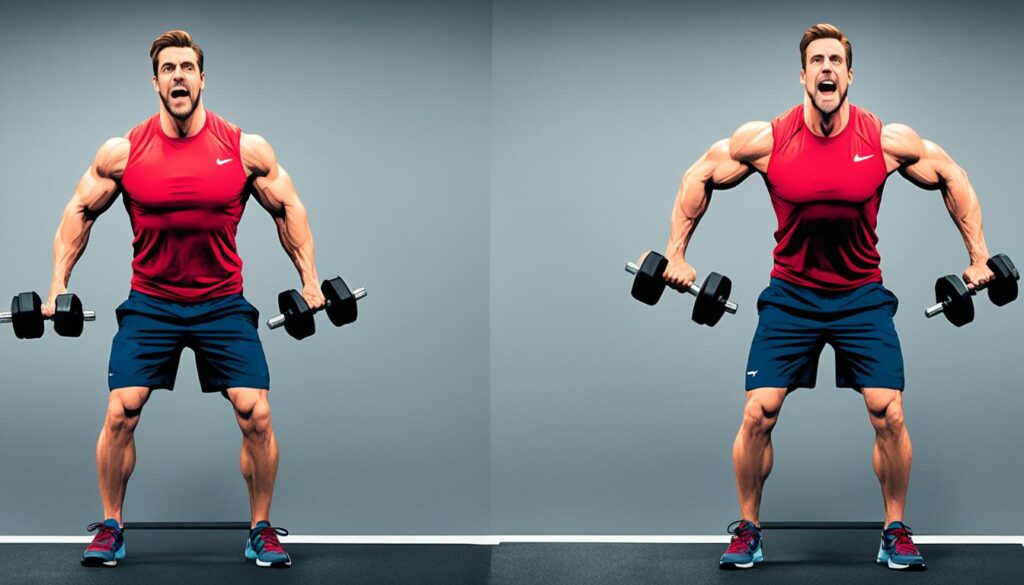Beginner’s Guide: dumbbell squats
Did you know that squats are considered one of the most effective exercises for building lower body strength? Whether you’re a fitness enthusiast or just starting your journey, incorporating squats into your routine can yield significant benefits. In particular, dumbbell squats are an excellent option for beginners, offering a simple yet challenging way to target various muscle groups.
With the right technique and guidance, you can unlock the full potential of dumbbell squats to sculpt your legs, strengthen your core, and improve overall muscle tone. In this comprehensive beginner’s guide, I will walk you through the step-by-step process of performing dumbbell squats correctly, ensuring you maximize results while minimizing the risk of injury.
So, let’s dive in and discover how to master the powerful benefits of dumbbell squats!
Key Takeaways:
- Dumbbell squats are an effective exercise for building lower body strength.
- They target multiple muscle groups, including the quadriceps, hamstrings, and glutes.
- Proper form and technique are crucial for maximizing results and preventing injuries.
- Dumbbell squats can be modified and progressed as you gain strength and confidence.
- Consult with a fitness professional to ensure you’re performing dumbbell squats correctly for your fitness level.
Understanding Dumbbell Squats
In this section, I will delve deeper into the mechanics and benefits of dumbbell squats. I will also explore variations such as the split squat and discuss their role in targeting specific muscle groups.
Mechanics of Dumbbell Squats
Dumbbell squats are a compound exercise that primarily targets the lower body, engaging muscles such as the quadriceps, hamstrings, glutes, and calves. The exercise involves holding a dumbbell in each hand, resting them at shoulder level, and performing a squatting motion.
The split squat is a variation of the dumbbell squat that focuses on unilateral training. This exercise involves elevating one foot behind you while the other foot remains firmly planted on the ground. It targets individual legs and helps correct muscle imbalances.
Benefits of Dumbbell Squats
Dumbbell squats offer numerous benefits for beginners. They improve lower body strength, stability, and overall functional movement. Regularly performing squats can also contribute to better performance in daily activities and other exercises.
The split squat, specifically, helps strengthen the stabilizing muscles of the hips, improves balance and coordination, and increases hip mobility. It is an effective exercise for athletes and individuals recovering from lower body injuries.
Split squats are a fantastic way to enhance unilateral strength and stability. By targeting each leg individually, you can even out imbalances and develop a stronger foundation.
Targeted Muscle Groups
The primary muscle groups targeted during dumbbell squats and split squats include:
| Muscle Group | Dumbbell Squats | Split Squats |
|---|---|---|
| Quadriceps | ✓ | ✓ |
| Hamstrings | ✓ | ✓ |
| Glutes | ✓ | ✓ |
| Calves | ✓ | ✓ |
| Core (Abdominals & Lower Back) | ✓ | ✓ |
By incorporating dumbbell squats and split squats into your workout routine, you can develop strength and tone in multiple muscle groups simultaneously.
Mastering Dumbbell Squat Form
When it comes to dumbbell squats, proper form is essential for maximizing your results and preventing injury. In this section, we will break down each step in detail, including foot placement, posture, and hand positioning, to help you master the correct form.
1. Foot Placement
Start by standing with your feet shoulder-width apart, toes pointing slightly outward. This will provide a stable base and allow for proper alignment throughout the movement.
2. Posture
Keep your chest up and your gaze forward throughout the exercise. Engage your core muscles by pulling your belly button toward your spine. This will help maintain a neutral spine and prevent rounding of the back.
3. Hand Positioning
Hold the dumbbells in each hand, allowing them to rest at your sides. Your palms can either face inward or be turned slightly outward, whichever feels most comfortable to you.
4. Squatting Motion
Initiate the squat by pushing your hips back and bending your knees. Keep your weight centered on your heels and lower your body until your thighs are parallel to the ground or slightly below. Avoid letting your knees cave inwards or extending your knees past your toes.
5. Return to Starting Position
Push through your heels and engage your glutes to return to the starting position, fully extending your hips and knees. Maintain control throughout the movement and avoid locking your knees at the top.
Proper form is the foundation of an effective dumbbell squat. By mastering the key aspects of foot placement, posture, and hand positioning, you can perform this exercise safely and efficiently, maximizing your results and minimizing the risk of injury.
Now that you have learned the essential elements of mastering the dumbbell squat form, you are ready to move on to the next section where we will explore strategies for building strength with dumbbell squats.
Building Strength with Dumbbell Squats
Incorporating dumbbell squats into your workout plan is a fantastic way to build strength and muscle effectively. By utilizing strategic rep ranges, weight progression, and different variations, you can maximize your gains and achieve your fitness goals. Let’s explore these strategies in detail:
Varying Rep Ranges
When performing dumbbell squats, it’s essential to consider the rep range that suits your goals. Here are three popular rep ranges and their respective benefits:
- Strength and Power: To focus on building raw strength and power, aim for a lower rep range of 4-6 repetitions per set. Use heavy weights that challenge your muscles to the maximum.
- Hypertrophy (Muscle Growth): If your goal is to increase muscle size, opt for a moderate rep range of 8-12 repetitions per set. Use weights that allow you to maintain proper form while reaching muscle fatigue.
- Endurance: To enhance muscular endurance and stamina, perform higher rep ranges of 15-20 repetitions per set. Select lighter weights that enable you to complete the desired number of reps with proper technique.
Progressive Weight Increase
Progressive overload is crucial for continual strength development. Gradually increasing the weight you use for dumbbell squats will challenge your muscles and contribute to consistent progress. Start with a weight that allows you to perform the desired number of reps with proper form. As you become stronger, gradually add more weight to the dumbbells, pushing yourself to new limits.
Variations to Enhance Results
To prevent plateaus and stimulate different muscle fibers, it’s beneficial to incorporate variations of dumbbell squats into your workout plan. Here are a few examples:
| Variation | Primary Muscles Targeted |
|---|---|
| Dumbbell Front Squat | Quadriceps, Glutes |
| Dumbbell Goblet Squat | Quadriceps, Hamstrings, Glutes, Core |
| Dumbbell Bulgarian Split Squat | Quadriceps, Hamstrings, Glutes |
| Dumbbell Sumo Squat | Quadriceps, Hamstrings, Glutes, Inner Thighs |
| Dumbbell Jump Squat | Quadriceps, Hamstrings, Glutes, Calves, Core |
Remember to incorporate these variations mindfully, maintaining proper form and gradually increasing the weight as you progress.
By implementing these strategies into your workout plan, you will optimize your results with dumbbell squats. Remember to listen to your body, practice proper form, and consult with a fitness professional if you have any concerns or questions. Now, let’s move on to the conclusion of our beginner’s guide to dumbbell squats.

Conclusion
In conclusion, incorporating dumbbell squats into your fitness routine is a wise choice for beginners seeking to strengthen their lower body. By following the techniques and tips outlined in this guide, you can confidently perform dumbbell squats with proper form, maximizing their effectiveness.
Dumbbell squats offer a versatile workout that targets multiple muscle groups simultaneously, including the quadriceps, hamstrings, glutes, and core. This compound exercise helps improve strength, stability, and overall functional fitness.
While dumbbell squats are an excellent addition to any workout regimen, it’s important to remember to consult with a fitness professional if you have any concerns or questions. They can provide personalized guidance, helping you tailor your routine to meet your specific fitness goals and abilities.
Incorporating variations of dumbbell squats such as the clean jerk can further challenge your muscles and add diversity to your workouts. However, it’s crucial to ensure you have mastered the basic dumbbell squat form before attempting more complex movements.
FAQ
How do I perform dumbbell squats?
To perform dumbbell squats, start by standing with your feet shoulder-width apart and holding a dumbbell in each hand at your sides. Engage your core, keep your back straight, and lower yourself into a squat position by bending your knees and pushing your hips back. Make sure your knees do not extend past your toes. Rise back up to the starting position by pressing through your heels and straightening your legs. Repeat for the desired number of repetitions.
What is a split squat?
A split squat is a variation of the dumbbell squat where one foot is positioned forward while the other foot is positioned behind. This exercise helps to target individual leg strength and stability, as well as increase hip mobility. To perform a split squat, start with one foot in front and the other foot behind you. Hold a dumbbell in each hand, lower yourself into a lunge position, and then push back up to the starting position. Switch the position of your feet and repeat with the other leg.
What are some key tips for dumbbell squats?
Some key tips for dumbbell squats include maintaining proper form by keeping your back straight, focusing on pushing your hips back rather than just bending your knees, and engaging your core throughout the movement. It’s also important to start with lighter weights and gradually increase the weight as you become more comfortable and confident in your form. Additionally, incorporating variations such as split squats and pulse squats can help target different muscle groups and add variety to your workout routine.
How can I master the form of dumbbell squats?
To master the form of dumbbell squats, start by practicing without weights or using lighter dumbbells. Focus on perfecting your form by ensuring your knees track in line with your toes, your back remains straight, and you maintain good posture throughout the exercise. It can also be helpful to work with a fitness professional or watch instructional videos to ensure you are performing the exercise correctly. Consistent practice and attention to detail will help you master the form over time.
How can I build strength with dumbbell squats?
To build strength with dumbbell squats, you can incorporate them into a well-rounded workout plan that includes other exercises for the lower body, such as lunges and deadlifts. Gradually increase the weight of the dumbbells as your strength improves, but always prioritize maintaining proper form. Varying the number of sets and repetitions can also help stimulate muscle growth and increase strength. It’s important to listen to your body and rest when needed to avoid overtraining.
